Having fun is key to rich and meaningful learning

Afterschool Team
July 17, 2013
Learning does not only take place when we are serious and quiet, says Eric Cooke. The senior student advisor at the University of Southampton, UK campus backs up the notion that learning can and should be fun and is required to authentic learning.

Every student can relate to sitting in a class trying not to doze off or listening to a brilliant lecturer but has no ability to engage students. Although some students are intrinsically motivated to overcome this situation, there are some who require a positive classroom environment to engage and motivate them.
So how should educators create that kind of environment that will trigger students to make connections and come up with "aha"moments?
"We encourage questioning at the beginning," says Cooke."Questions make you fall in love with the subject because you get to form dialogues between your collegeaus which eventually becomes an enjoyable process."
At Southampton, students need to pass their modules. If a student does exactly what he is told by his professor, he gets 68 per cent. But to get over the 70 per cent benchmark, students will have to do more than what they are told.
"We want our students to prove their real understanding beyond of what is written and building confidence, shared learning experience and peer pressure works well with us," he explains.
For areas like engineering, the knowledge from books alone won't make a student exceptional as there is pressing need for them to innovate and improve on existing knowledge and elements to be experts in their field.
The University of Southampton encourages this quality through its engineering programmes and laboratories where students can question existing structures and take on the challenge of changing the world for the better.
"I think that the future is now being created to a large extent by engineers. Reflecting the way we live, engineering dominates our lives, " says Cooke.
Not your ordinary flying carpets
Unlike in other universities, students at Southampton are not trained to reproduce course notes by heart. Creativity and confidence is being built during the final years.

Third year students are required to come up with challenging individual projects. One particular student had a keen interest in biometrics (identification of humans by their characteristics or traits) that he came up with an intelligent carpet that identifies people by the way their legs move when they walk. The results of this project were published in an IEEE journal and presented in a conference in the US.
Another powerful carpet is being developed by researchers at Southampton. This carpet comes with embedded films that can charge batteries of mobile devices such as mobile phones and MP3 players. People will just have to walk on the carpet to harvest energy.
"Our staff is keen to share research attitude to our students. We make significant investments in the infrastructure by adding top of the range equipment. We trust the students to be good enough to use that. And they are!"
Currently, Southampton is recreating its electronic and electrical laboratory in its Malaysia campus in EduCity, Iskandar South Johor. They have recently invested RM1.2 million for new equipment.
Southampton’s degree in Electrical and Electronics Engineering features a variety of innovative teaching methods and assessment including coursework, group work and exams. Future graduates are required to complete a four-year study with their first two years of study hosted at the Malaysia Campus and the final two years at the UK campus in Southampton. Students at the Malaysia Campus benefit the same teaching modules as those on the first two years in Southampton at an overall cost of 40 per cent less.
-----
Written by Lyn Cacha



